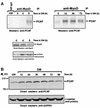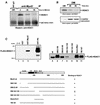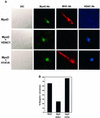A role for histone deacetylase HDAC1 in modulating the transcriptional activity of MyoD: inhibition of the myogenic program
- PMID: 11285237
- PMCID: PMC145490
- DOI: 10.1093/emboj/20.7.1739
A role for histone deacetylase HDAC1 in modulating the transcriptional activity of MyoD: inhibition of the myogenic program
Abstract
The molecular mechanism(s) that are responsible for suppressing MyoD's transcriptional activities in undifferentiated skeletal muscle cells have not yet been determined. We now show that MyoD associates with a histone deacetylase-1 (HDAC1) in these cells and that this interaction is responsible for silencing MyoD-dependent transcription of endogenous p21 as well as muscle-specific genes. Specifically, we present evidence that HDAC1 can bind directly to MyoD and use an acetylated MyoD as a substrate in vitro, whereas a mutant version of HDAC1 (H141A) can not. Further more, this mutant also fails to repress MyoD-mediated transcription in vivo, and unlike wild-type HDAC1 it can not inhibit myogenic conversion, as judged by confocal microscopy. Finally, we show that an endogenous MyoD can be acetylated upon its conversion to a hypophosphorylated state and only when the cells have been induced to differentiate. These results provide for a model which postulates that MyoD may be co-dependent on HDAC1 and P/CAF for temporally controlling its transcriptional activity before and after the differentiation of muscle cells.
Figures






Similar articles
-
Molecular mechanisms of myogenic coactivation by p300: direct interaction with the activation domain of MyoD and with the MADS box of MEF2C.Mol Cell Biol. 1997 Feb;17(2):1010-26. doi: 10.1128/MCB.17.2.1010. Mol Cell Biol. 1997. PMID: 9001254 Free PMC article.
-
Interaction between acetylated MyoD and the bromodomain of CBP and/or p300.Mol Cell Biol. 2001 Aug;21(16):5312-20. doi: 10.1128/MCB.21.16.5312-5320.2001. Mol Cell Biol. 2001. PMID: 11463815 Free PMC article.
-
Class I histone deacetylases sequentially interact with MyoD and pRb during skeletal myogenesis.Mol Cell. 2001 Oct;8(4):885-97. doi: 10.1016/s1097-2765(01)00373-2. Mol Cell. 2001. PMID: 11684023
-
Control of muscle development by dueling HATs and HDACs.Curr Opin Genet Dev. 2001 Oct;11(5):497-504. doi: 10.1016/s0959-437x(00)00224-0. Curr Opin Genet Dev. 2001. PMID: 11532390 Review.
-
Crosstalk between cell cycle regulators and the myogenic factor MyoD in skeletal myoblasts.Cell Mol Life Sci. 2001 Apr;58(4):571-9. doi: 10.1007/PL00000882. Cell Mol Life Sci. 2001. PMID: 11361092 Free PMC article. Review.
Cited by
-
p38α MAPK disables KMT1A-mediated repression of myogenic differentiation program.Skelet Muscle. 2016 Aug 22;6:28. doi: 10.1186/s13395-016-0100-z. eCollection 2016. Skelet Muscle. 2016. PMID: 27551368 Free PMC article.
-
The p65 (RelA) subunit of NF-kappaB interacts with the histone deacetylase (HDAC) corepressors HDAC1 and HDAC2 to negatively regulate gene expression.Mol Cell Biol. 2001 Oct;21(20):7065-77. doi: 10.1128/MCB.21.20.7065-7077.2001. Mol Cell Biol. 2001. PMID: 11564889 Free PMC article.
-
Nuclear function of Smad7 promotes myogenesis.Mol Cell Biol. 2010 Feb;30(3):722-35. doi: 10.1128/MCB.01005-09. Epub 2009 Dec 7. Mol Cell Biol. 2010. PMID: 19995910 Free PMC article.
-
Small molecule inhibition of PAX3-FOXO1 through AKT activation suppresses malignant phenotypes of alveolar rhabdomyosarcoma.Mol Cancer Ther. 2013 Dec;12(12):2663-74. doi: 10.1158/1535-7163.MCT-13-0277. Epub 2013 Oct 9. Mol Cancer Ther. 2013. PMID: 24107448 Free PMC article.
-
Temporal regulation of chromatin during myoblast differentiation.Semin Cell Dev Biol. 2017 Dec;72:77-86. doi: 10.1016/j.semcdb.2017.10.022. Epub 2017 Oct 28. Semin Cell Dev Biol. 2017. PMID: 29079444 Free PMC article. Review.
References
-
- Arnold H.-H. and Winter,B. (1998) Muscle differentiation: more complexity to the network of myogenic regulators. Curr. Opin. Genet. Dev., 8, 539–544. - PubMed
-
- Benezra R., Davis,R.L., Lockshon,D., Turner,D.L. and Weintraub,H. (1990) The protein Id: a negative regulator of helix–loop–helix DNA binding proteins. Cell, 61, 49–59. - PubMed
Publication types
MeSH terms
Substances
Grants and funding
LinkOut - more resources
Full Text Sources
Other Literature Sources
Miscellaneous

